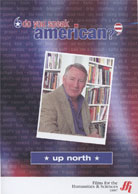
Do you Speak American? 2005
Distributed by Films Media Group, PO Box 2053, Princeton, New Jersey 08543-2053; 800-257-5126
Produced by MacNeil/Lehrer - Paladin/InVision with Thirteen WNET
Director n/a
DVD, color, 180 min.
College - Adult
American Studies, Language, Multicultural Studies, Popular Culture
Date Entered: 06/21/2005
Reviewed by Charles Burkart, Head, Audiovisual Library, West Virginia University, Morgantown, WVTwenty years ago PBS broadcast the groundbreaking, award-wining television series, The Story of English. This comprehensive series remains the standard college video series on English linguistics. Now Robert MacNeil, original narrator and co-writer of that prevailing work, has launched a new series on American English called Do you Speak American?
Do you Speak American? covers northern, midlands, southern and western regional spoken dialects. The format of this new series resembles the old one - Robert MacNeil interviews scholarly linguists, local celebrities, and ordinary people about American English dialect and pronunciations. In addition, it is an amusing road show that has Mr. MacNeil traveling in a variety of vehicles across the dialect regions of the United States.
So what has changed linguistically since the release of The Story of English? Not as much as you might think. Certainly, voice activated computers, "vowel shift", tension between "prescriptivism" and "descriptivism", and the Internet revolution with its chat rooms are all new linguistic territory. However, you shouldn't think that Do you Speak American? replaces the older, but more scholarly and comprehensive Story of English. It is more of a continuation, elaboration and update of the original series.
There are three discs in the Do you Speak American? series: Up North, Down South, and Out West. These discs are divided into short, self contained sections that can be conveniently accessed through the DVD chapter menus. This is a very useful teaching tool compared to the format of The Story of English. Films for the Humanities and Sciences also provide a handy written summary list of sections in the paper DVD insert.
Picture quality (except on the bleary Story of English segments) is both sharp and bright. Furthermore, the dialects are easy to understand because of the clear sound quality. New words or expressions are sometimes displayed graphically on the screen. I am also happy to report that the three discs played flawlessly on my old DVD player -previously, I had problems playing some Films for the Humanities and Sciences discs on my older player. Public performance, as well as limited closed circuit rights are included with the purchase price from Films for the Humanities and Sciences.
My only criticism of the new series is its sometimes facile answers to whether Spanish or Spanglish will replace English in certain regions of the country. With so many Spanish speaking immigrants coming to America, the linguistic pull of Mexico and Latin America is exerting a powerful influence on the Southwest, as well as the East Coast.
Walt Wolfram, North Carolina State University Professor of Linguistics, says that since the telecast of The Story of English people have come to celebrate regional dialect differences. Certainly, this is what Do you Speak American? does best - it is a celebration of the American language. College and university libraries will definitely want to purchase it for their collections. It could also be useful in high schools and public libraries. Highly recommended.